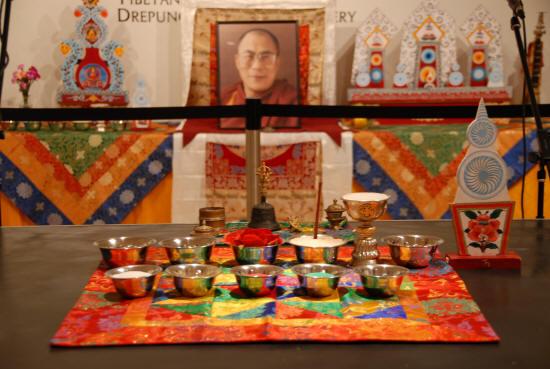Ritual Items
Offering Bowls:
Traditionally sold in a set of seven, these offering bowls are placed on altars to symbolize the five senses, the journey of enlightenment, and the dedication of all bodily actions to the gods. They may be used for many purposes, but ours will be featured near the mandala holding the brightly colored sands.
Vajra and Bell Set:
This set of artifacts includes a brass vajra and a bell, made of more than 12 types of metal, that is also featured in tantric music. They are often used in meditation, or to balance the environment of the home. Together, they represent the combination of male and female energies necessary for enlightenment.
In Sanskrit, vajra means “thunderbolt” and “diamond,” and is an artifact with the ability to work through ignorance (as a thunderbolt) without being destroyed (because it is indestructible, like a diamond). It is used in the dismantling of the mandala as part of the closing ceremony.
Mandala Offering Set:
This 3-D representation of a mandala is typically filled with rice, as an offering to the gods. It is often used during meditation and represents the balance of the outer world and inner mind.
Butter Lamps:
These lamps adorn household altars, temples, and other places of worship. They often feature one or more of the Eight Auspicious Symbols. Yak butter, a fatty substance used in Tibet, is placed inside of the lamps and burned to represent enlightenment, wisdom, and sight.
The Face of Wrathful Compassion:
On this artifact is the face of Mahakala, one of the eight protective deities in Buddhism. Known for compassion, this god took on the form of a wrathful guardian to better protect beings by scaring away evil spirits.
This apron is worn by Black Hat Dancers, who will perform as part of the opening ceremony to bless the area of the mandala. Displaying this artifact invites the blessings of the guardian protectors into the room.
Altar Cloths and Ritual Table Cloths:
These silk cloths are designed to hold ritual implements and sacred objects. Their bright colors and patterns also beautify and brighten household alters.
Bumpa Vase:
Ritual vases, made of copper and bronze, used in spiritual rites and meditation. During the closing ceremonies, the sand is placed in a vase and emptied into a flowing body of water to spread the healing powers of the mandala through the world.
Namgyal Vase:
A traditional ritual vase made of copper and featuring silver-toned dragons on the exterior. It is used for storing spiritual energies and can be decorated with fresh or dried flowers.
Damaru Hand-drum:
These drums are used during meditation and are carved from wood to look like two human skulls placed against each other. They symbolize tummo, or the ability to control inner body processes (such as producing body heat) with the mind.
Tingsha-Cymbals:
These cymbals, used in meditation and as an instrument in tantric music, are made of 17 metals and create a unique and haunting sound. They are used to bring harmony with nature spirits, and to cleanse and uplift the environment. Look for them during the opening and closing ceremonies, and on the display in the Great Hal



